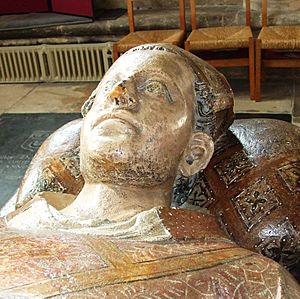John Droxford facts for kids
Quick facts for kids John Droxford |
|
|---|---|
| Bishop of Bath and Wells | |

Effigy of John Droxford in Wells Cathedral
|
|
| Elected | 5 February 1309 |
| Reign ended | 9 May 1329 |
| Predecessor | Walter Haselshaw |
| Successor | Ralph of Shrewsbury |
| Orders | |
| Consecration | 9 November 1309 |
| Personal details | |
| Died | 9 May 1329 |
| Buried | Wells Cathedral |
| Denomination | Catholic |
John Droxford (sometimes called John Drokensford) was an important leader in the church. He became the Bishop of Bath and Wells in 1309 and served until he passed away in 1329.
Contents
John Droxford's Early Life and Work
John Droxford was likely born in a place called Drokensford, which is now Droxford, in Hampshire, England.
Working for King Edward I
John Droxford held important jobs for King Edward I. From 1291 to 1295, he was the King's Controller of the Wardrobe. This meant he managed the king's household and money. After that, he became the Keeper of the Wardrobe until 1309. These roles meant he was always close to the king.
He traveled with King Edward I on trips to Scotland in 1291 and 1296. In 1297, he even temporarily managed the king's money as the Treasurer. He also joined the king on another trip to Scotland in 1303–1304.
Many Important Roles
Because of his good service, John Droxford received many church positions. He was a rector (a church leader) in several places, including Droxford and other towns in Yorkshire and Cambridgeshire. He also held prebends, which are special roles in churches like Lichfield, Lincoln, and Wells. He was even a chaplain to the Pope!
Besides his church roles, he also earned a lot of money from other jobs. He owned many homes in places like Surrey, Hampshire, and Kent. He also had land in Chute Forest, Wiltshire and Windsor Forest. Sometimes, people mistakenly called him the Chancellor or Keeper of the Great Seal. This was because he sometimes held the king's important seal for a few days, but he wasn't officially in those top jobs.
Becoming a Bishop
After King Edward I died, John Droxford stopped working for the royal household. He then worked in the exchequer, which managed the country's money, as a chancellor for a short time.
In 1308, King Edward II suggested John Droxford to be the new Bishop of Bath and Wells. He officially became bishop in 1309. About a year later, he was formally welcomed at Wells Cathedral.
Life as a Bishop
For the first four years as bishop, John Droxford was not often in his diocese (the area he was in charge of). He wrote in 1312 that "political troubles" kept him away. Later, he spent more time in Somerset, though he still traveled a lot to London and his own estates.
He didn't stay in one place like Bath or Wells. Instead, he moved between many of the sixteen or more manor-houses that belonged to the bishopric. He traveled with a large group of people. John Droxford was known for being grand and generous. However, like some other bishops, he sometimes used his power to help his family too much. For example, he gave a church role to a young boy who was not even a priest. He also had some disagreements with the church chapter (the group of clergy who helped him), but these were settled in 1321.
Challenges with the King
Even though John Droxford was left in charge when King Edward II and Queen Isabella went to France in 1313, he didn't get as many important government jobs as others. This might be why he became unhappy with the king.
In 1310, he joined a group asking for special ordainers to help run the government. In 1321, he tried to make peace between the king and some unhappy lords. However, he was also involved in a rebellion against the king. In 1323, King Edward II complained to Pope John XXII about John Droxford's actions. The king even asked for him to be moved to a church position outside of England.
In 1325, John Droxford signed a letter with other bishops asking the queen to return to her husband. But in 1327, he took an oath to support the queen and her son at the Guildhall in London.
Death and Burial
John Droxford passed away at his manor-house in Dogmersfield, Hampshire, on May 9, 1329. He was buried in St Katharine's Chapel in Wells Cathedral. You can still see his tomb there today. Just two months before he died, he set up a special fund to support prayers at the altar closest to his grave.

